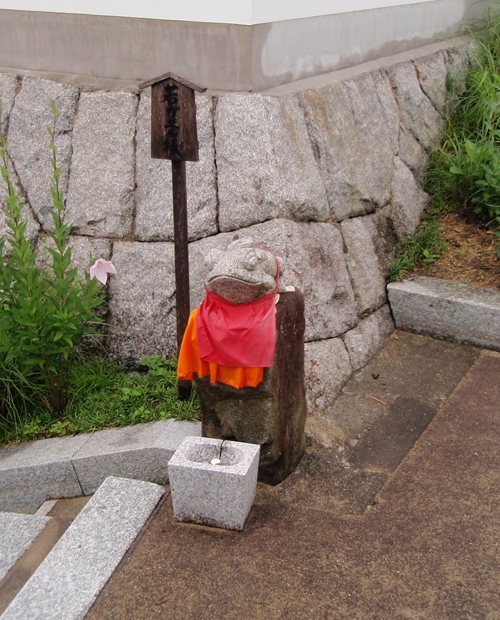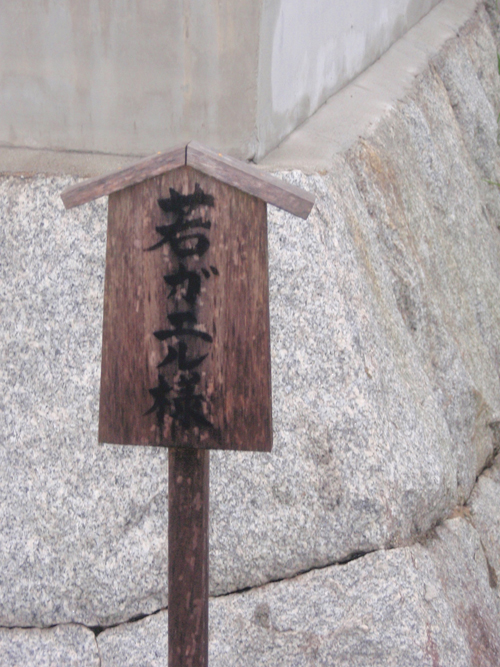A Frog Blog
Last weekend, when my language partner and I chatted about world affairs, I discovered this fun term in the dictionary:
井蛙の見 (せいあのけん: narrow perspective) well + frog + to see
Kensuke-san called it a difficult expression, one that he hadn't heard. Nevertheless, he immediately knew the situation to which it referred.
Here's the story: A frog is living in a well, and because it contains water, he believes he's in the ocean. He also thinks he's seeing the whole world. Of course, he glimpses nothing but the narrow shaft of the well.
I have since learned that this story originated in a book that a Chinese philosopher published in the fourth century BCE.
I love this story. It's hard to say exactly why. Maybe it's that Haruki Murakami often writes about wells, particularly as they relate to the unconscious mind. The frog tale is about consciousness, so it seems a perfect fit.
Perhaps I also love the story because there's something deeply satisfying about 井, which means "well." I adore the neat symmetry and the way it reminds me of tic-tac-toe. I also find wells fascinating, and my excitement is again a mystery to me. Maybe it's because they belong to two worlds at once—the visible, dry world above, as well as the submerged watery world, Or it could be that they hark back to the ingenious way in which humans used to do things before we had water and electricity traveling directly into our houses. I also find the shape of most wells utterly charming.
But let's not forget about the frog in the expression above. That creature really brings 井蛙の見 to life! This frog also reminds me that, at a temple in the Rokko Mountains above Kobe, I met three frogs last month. Not living frogs, as it happens, but frogs full of life all the same.
It was at Mayasan Tenjo-ji Temple (摩耶山天上寺, まやさんてんじょうじ), which the Indian monk Hodo-senninn (法道仙人) first built in 646 CE. That sounds like a long time ago, and it was, but it was still about a millennium after the Chinese philosopher wrote about that myopic frog!
The temple grounds climb a considerable way up a hillside, through the trees, past stone monuments. When my husband and I went there with my proofreader, Hideo-san, we were the sole visitors. Fog swirled around us, making the scene downright mist-ical!
Atop a long flight of stairs, we encountered Frog 1:

Photo Credit: Eve Kushner
Made of stone, she had a much smaller frog on her back (Frog 1A, I suppose!).

Photo Credit: Eve Kushner
Here's a close-up of the nearby sign:

Photo Credit: Eve Kushner
It says the following:
若ガエル様 (わかガエルさま)
The katakana offers a play on words; its unvoiced version, かえる, can correspond to either 蛙 (a non-Joyo kanji meaning "frog") or 返る (to return). As 若 means "young," 若ガエル (わかがえる) means both "young frog" and "to return young."
As for 様 (-さま), it provides another double meaning. First, it's an honorific title for the frog. Second, a samurai would have addressed the son of his lord as 若様 (わかさま: my young lord).
If we perceive the whole name as 若様 with -ガエル inserted in the middle, we can translate it as "the young frog lord who could make you young again."
After meeting Frog 1, we passed through an inviting set of wooden gates and found ourselves in a large plaza featuring several temple buildings, a large bell, monuments, statues, and Frog 2.

Photo Credit: Eve Kushner
This wooden guy had wonderfully webby feet. (I'm just guessing at the genders, by the way!)

Photo Credit: Eve Kushner
He also had a basket (all the frogs appeared to be beggars!), a set of bibs (which I'll explain later), and a sign of his own:
またのご来山をお待ち申し上げます
無事カエル
ご来山各位
Let's take it line by line (or column by column). The end of the long line is just a polite flourish, so we can omit it, translating the sentence as follows: "I'm waiting for you to come back to the mountain safely." The "waiting" comes from 待つ (まつ: to wait). And 来 gives us "to come." In this context, 山 refers to the particular temple, 摩耶山天上寺. Hideo-san explains, "Many temples have 山 in their names, even if they're located in flat areas. You can translate it either as 'mountain' or 'temple.'" The reason? Temples were originally in the mountains!
As for 無事カエル, therein lies the second frog's pun, although it's the same joke we saw before; カエル can mean "frog" or "to return." Meanwhile, 無事 (ぶじ) means "safety," so we have "return safely" or "safe frog."
If this sign were a piece of correspondence, as it's supposed to be, ご来山各位 would function as the 宛名 (あてな: (addressee's) name; (recipient's) name and address). In this case, the letter is from the 無事カエル and is addressed to ご来山各位 (ごらいさんかくい: everyone visiting the temple).
On to Frog 3. A stone creature with enormous eyes, he's called the "congratulations frog" (おめでた蛙, おめでたカエル).

Photo Credit: Eve Kushner
If you caress his head, you'll supposedly be blessed with domestic bliss, a newborn, and happy children. That's more or less what it says on the adjacent stone monument.
This frog is a mascot representing the temple. In fact, according to one website, the frog is enshrined there! Really?! Yes, the site says the following:
摩耶山天上寺の境内には、大きな目玉のカエルさん「おめでた蛙」が祀られています。
The sentence may look frightening, but we can pick it apart easily enough. We already know 摩耶山天上寺 (the temple name), カエル (in all its meanings), and おめでた蛙 ("congratulations" frog). All we need are these bits of vocabulary, and we're good to go:
境内 (けいだい: grounds (esp. of shrines and temples))
大きな目玉 (おおきなめだま: huge eyeballs)
祀る (まつる: to enshrine, shown in its passive and present-progressive form)
The last kanji is non-Joyo.
If frogs can have such powers, I can certainly see enshrining them! But why a frog in particular?
Hideo-san asked the temple staff via email, and they replied that the mountain has a rich ecosystem with many types of frogs. They then added this, which will give you a kanji workout if you're up for it:
またカエルは生命の再生を象徴的にあらわすものともいわれています。生命の豊かさや再生をあらわす蛙。
Frogs are said to be a symbol of a rich life and rebirth.
安産祈願のお寺として知られる当寺としては、その蛙を大切にしてまいりました。
This temple is known as one where people pray for an easy birth. As such, the temple has regarded frogs as important.
ちなみに蛙は目が大きいため、眼病の治癒にご利益があるともいわれ、蛙さまの目を触って眼病平癒を祈願していく方もおられます。
By the way, frogs have big eyes, so some people touch the frog's eyes as they pray for their eye diseases to be cured.
And we thought frogs only gave you warts!
How about the bibs, then? Do they have any connection to the drooly children born after the frog caress?
No, Hideo-san mentions that other guardian statues, such as Jizo (お地蔵さん, おじぞうさん), also wear red bibs, which are believed to take away all earthly desires (known as 煩悩, ぼんのう). Wait, the guardians have no earthly desires, but touching their heads brings on pregnancy?
One more tidbit that I gleaned from a site: they're called not only bibs but also aprons (エプロン). Hard to tell the difference when it's on a frog!
If it seems that I've gone way overboard in this investigation, that's nothing compared with one Japanese blogger who runs a website called All Kinds of Frogs. The mission statement says, "The person administering this blog loves frogs more than anything else and is doing original research on frog culture" Frog culture! He or she has written 16 frog blogs just about Hyogo Prefecture (which is where Mayasan is), also covering 37 more prefectures and three foreign countries. For photos of the Mayasan frogs from every angle on that site, check this link.
Have a great weekend! May it be frogful (if you wish it to be)!


Comments